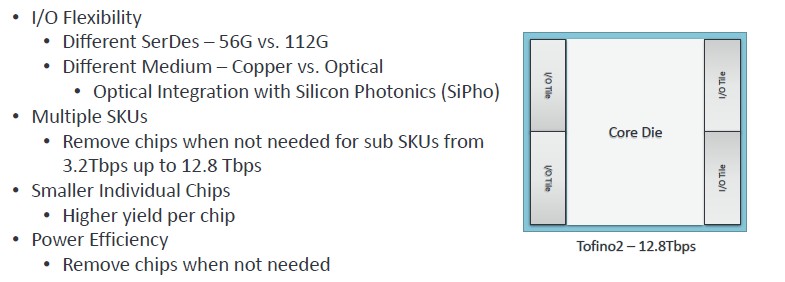A product announcement introduced the tofino2 ASIC. A subsequent but really ugly data sheet contained the following table:
|
|
2.2.3
Barefoot the Tofino 2 chip 7nm plus chiplet switch ASIC
Figure 2.12 Barefoot's Tofino2
Linley Newsletter
Barefoot Joins 400GbE-Switch ClubJanuary 8, 2019 Author: Bob Wheeler Barefoot Networks plans to bring programmability to 400G Ethernet (400GbE), and its past performance suggests it can. This month, it preannounced its Tofino 2 second-generation switch chip for 1H19 sampling. Employing 50Gbps PAM4 serdes, the new product delivers 12.8Tbps of bandwidth—double that of the first Tofino. Like its predecessor, Tofino 2 is programmable using the P4 language. It’s also the first announced 12.8Tbps switch using 7nm technology, promising lower power than 16nm designs achieve. Tofino 2 uses the same number of pipelines as the shipping Tofino. The only architectural change between generations is packet-processing extensions (dubbed PPX) to the match+action units (MAUs), but Barefoot withheld details. The company created three Tofino 2 families: the U (ultra) family provides the most MAUs and associated memory, the M (mainstream) family implements fewer MAUs, and the H (hyperscale) family omits PPX and offers the lowest latency. The 12.8Tbps versions handle 32x400GbE, 128x100GbE, and 256x50GbE ports. Barefoot will also sell 8.0Tbps and 6.4Tbps versions. Tofino 2 samples will trail those of Broadcom’s 12.8Tbps Tomahawk 3 by about 18 months. Furthermore, Broadcom and Innovium have both started production of their respective 12.8Tbps chips, enabling the first high-density 400GbE switch systems. On the plus side, Barefoot’s use of 7nm technology should deliver superior power dissipation for the new design. The startup has demonstrated that a programmable switch chip can directly compete with a fixed-function device, minimizing any programmability “tax.” |
